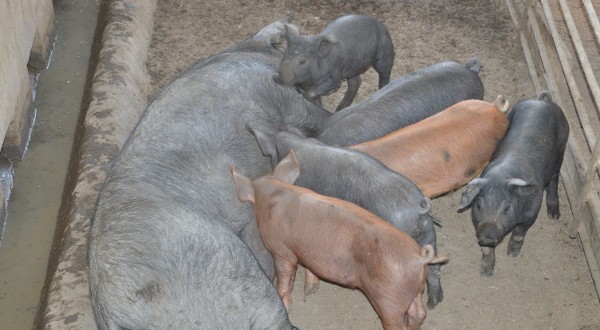Let’s imagine the following: in the future, it will be possible to buy a kilo of traditional chouriço sausage made from the meat of the Iberian pig, which today costs around 17 euros, for €1.99 at any supermarket – but with genetically modified pork processed in the USA. Our future “piri piri” chicken will come from Kentucky and will cost 99 cents. Let us imagine too that our bread, butter, milk, cheese, olive oil, potatoes, pasta and rice, among other products (all of which we need to lead a good life) will be bought in a Chinese or American shop at a much lower price… let us imagine eating foodstuffs that are wholly produced and processed outside Portugal. This fictional scenario will perhaps become reality if the EU goes ahead with an agreement known as TTIP (Transatlantic Trade and Investment Partnership).
The factory “Sitio da Serra de Monchique” in Picota is entirely dedicated to the production of sausages and dry-cured ham made from the meat of the Iberian pig. The sausages are produced in artisan style, from the rearing of the pigs to the fattening stage and finally to the slaughterhouse where the meats are appropriately treated for processing into products for consumption.
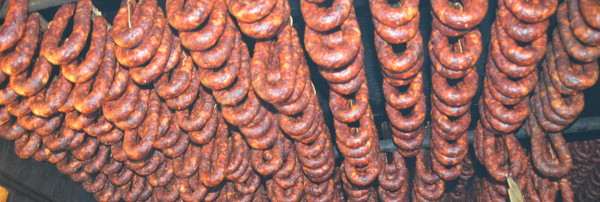
Idália Duarte and António Sequeira Duarte are the owners of the cured meat factory “Sítio da Serra de Monchique”. Pork production was always a means of doing business for this family, where according to Idália, her parents “started the business to sell small quantities at the grocer’s and I ended up getting the bug.”
Family know-how, passed from generation to generation, enabled Idália Duarte to set up a cured meat business over ten years ago. This is where she started “rearing pigs for our own consumption,” and then “started slaughtering them to take to the fair, and later produced a larger quantity and started to produce them for processing in a factory.”
This company at present employs 16 workers who do important jobs for its success, representing an annual salary bill of 120.000 euros.
As this small family business grew, Idália Duarte passed on her love and knowledge of the job on to her three children. All of them currently work in the industry, following in their parents’ footsteps. The youngest daughter, 33-year-old Laura Duarte, is responsible for the production of the cured meats because “she never left the business. She went to study at university and whenever she was on holiday she was here working with us. She trained in food engineering. She’s my right-hand woman,” Idália Duarte says proudly.
“A short but happy life”
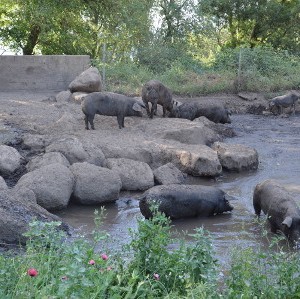 The days start very early for people working at this factory. All the tasks, from rearing the pigs to the production phase of products for consumption, require attention and dedication from the company’s staff.
The days start very early for people working at this factory. All the tasks, from rearing the pigs to the production phase of products for consumption, require attention and dedication from the company’s staff.
The team follow each stage in the pigs’ development attentively, ensuring that the animals enjoy a happy life until they get to the slaughterhouse.
The pigs are divided into different sections, depending on their phase of growth. The animals can roam naturally over the whole plot: “they run around freely, which makes the meat much tastier. They run around a lot in the pasture. This means that they have more muscle and, in this way, that they meat is much tastier,” says Idália Duarte.
The piglets are kept with their mother during the suckling phase. The teeth are clipped to prevent the points puncturing the mother’s teats.
The suckling pigs are castrated when they are still young to make the meat tastier. “The meat of the females is always tastier than that of the males although there is a difference here: the male pigs are all castrated. In the big supermarkets, the pigs never taste as good because they aren’t castrated,” António Sequeira Duarte explains.
After the “recria” phase (1), they move on to the fattening phase, during which, according to António Duarte Sequeira, they are fed with “good feed based on maize and cereals.” The pigs are kept in a large open area where they can run around freely. These animals love the mud pool where they can be completely submerged.
The experienced eyes of those who have been working in this business for a long time can tell which of the pigs are ready for slaughtering. António Duarte Sequeira sees the approximate size of the animal, which should preferably be between 80 and 90 kilos. “A pig should never be processed into cured meat when it is very young, so this is always done when they are ten or twelve months or older,” says Idália Duarte.
The selected animals are guided into a pen. Then they continue through a chute to the vehicle to prevent the pigs getting anxious, as António Sequeira Duarte explains during the process. The pigs are loaded into a vehicle that is properly equipped to transport them, with sawdust on the floor to ensure that the animals are comfortable during the journey to the slaughterhouse. The number of animals transported at one time is limited to stop them falling on top of each other. The trip is done twice a week, with ten pigs each time. An average of 1040 animals are killed per year, with an annual production of some 70 tonnes (2014 figure).
When they arrive at the slaughterhouse in the municipality of Odemira, it is already dark and the animals are all resting, snuggling up to each other. After the journey, they are kept in small compartments and are later moved on to be slaughtered. “Their lives are short but happy,” according to António Sequeira Duarte.
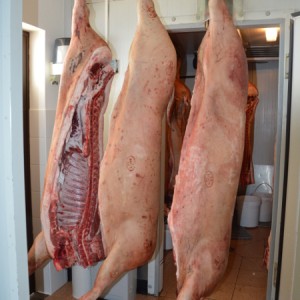 Once on the slaughter line, each pig is kept in an area with a high level of CO2, which induces a state of somnolence and anaesthesia. After it is checked that the animal is anaesthetised, a sticking knife is used on the animal’s neck so that the pig is properly bled without feeling any pain. The animal dies from lack of blood, and without suffering at all. Once dead, the animals are hung on an overhead line where they pass through several stages of treatment – washing, singeing, and finally the removal of all the dead skin.
Once on the slaughter line, each pig is kept in an area with a high level of CO2, which induces a state of somnolence and anaesthesia. After it is checked that the animal is anaesthetised, a sticking knife is used on the animal’s neck so that the pig is properly bled without feeling any pain. The animal dies from lack of blood, and without suffering at all. Once dead, the animals are hung on an overhead line where they pass through several stages of treatment – washing, singeing, and finally the removal of all the dead skin.
At the end of the different stages, the pig undergoes various microbiological, physical and chemical analyses to test the quality of the animal’s meat. Only after it reaches a specific temperature can the meat be transported back to the factory, in order to ensure its quality.
The work at the factory
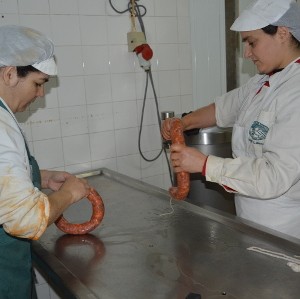 At the factory, once they receive the pigs, the work begins straight away, making use of all of the animals’ meat. This is turned into hams and sausages, rigorously following the principles of traditional manufacture.
At the factory, once they receive the pigs, the work begins straight away, making use of all of the animals’ meat. This is turned into hams and sausages, rigorously following the principles of traditional manufacture.
The work room is immediately divided into sections, where the different parts of the pork are dealt with. Each member of staff occupies a work table, and does just one job: the cutting of the stomachs, the mincing of the meat and the production of the sausages.
“The different meats are all separated when the pigs arrive. The softer meat with more blood and fat goes to make “morcela” (blood sausage). All the best lean meat goes to make the “chouriças”, the sausages. The legs are used for making “presunto” (dry cured ham), Laura Duarte explains.
The secret of the authentic flavour of the cured meats is the fact that they are only made with best quality meat. But there’s more to it: garlic, salt, pepper paste, dried paprika, wine and vinegar are all part of the recipe.
“The mixture has all been blended and kneaded, and now we start to fill the intestines with the meat using the sausage stuffer,” says Laura Duarte. She also adds: “we tie all the intestines by hand.”
Once the trolley is full, the sausages are sent to the smoking room where the ceiling is covered with a huge number of sausages, duly identified by batches. The sausages “hang on the line to drain for about 15 days.”
While the sausages were being hung up, the stove was already on at medium temperature to fry the “torresmos” (like pork crackling) and at the same time to smoke some of the sausages placed above the heat. The wood that is used has to be of a specific kind because “no wood containing resin can be used as it gives the sausage a bad flavour.”
And so, at the factory “Sítio da Serra de Monchique”, the pork is used to make different products for consumption: lard, sausages, different kinds of “morcela” and “farinheira”, “alheiras”, dry-cured ham, different pork meats, “toucinho”, crackling and cooked pork loin with lard.
The artisan production of the sausages ensures their quality, and the typical flavour of pork merits special praise. This demands hard work and dedication from all those involved, whose days start early and end late, with a company that proudly states: “Everything here is made by hand, using very old recipes.”
Idália Duarte and António Duarte Sequeira
Mobile phones: 967 690 415 | 961 467 417
Email: idaliaduartelda@hotmail.com
Fábrica de Enchidos (Sausage Factory) Sítio da Serra – 8550-381 Monchique
Telephone: 282 912 011
Talho-Loja de Porco preto (Butcher’s)
Rua Serpa Pinto nº18 – 8550-467 Monchique
Telephone: 282 913 461
Pastelaria Doce e Salgados (Cake Shop)
Largo Pé da Cruz, Monchique
 Eco123 Revista da Economia e Ecologia
Eco123 Revista da Economia e Ecologia

